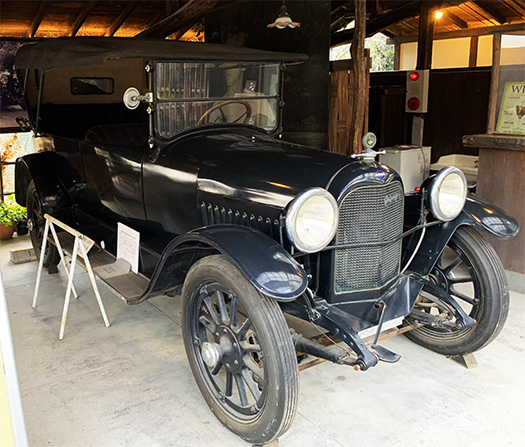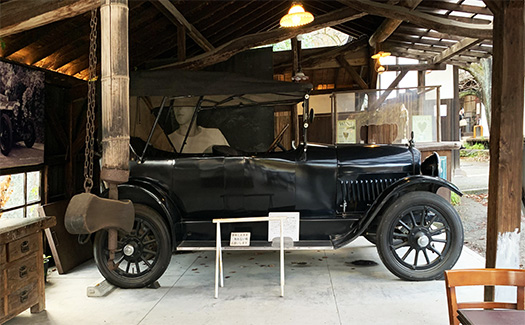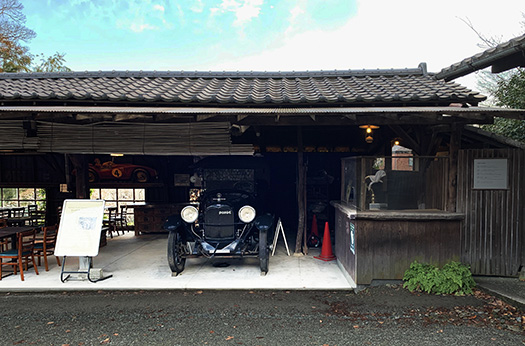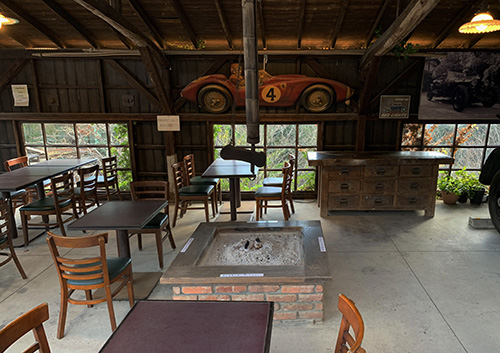

武相荘の亭主である白洲次郎氏は先般来触れているように
江戸期の兵庫県での武家階級出自で、神戸の開港とともに
西洋交易が時代の先端を形成すると見通し貿易ビジネスに向かった家系。
そして貿易事業にはかれらの社会に飛び込むのが早道と考えて
ハーバードとか、ケンブリッジに入学して人脈形成に勤しんだ。
それが時代の波をしっかりつかんでファミリーとして経済的成功を得た。
事業は一度、次郎氏の先代の時に倒産しているけれど、
蓄えた資産で悠々たる経済人としての基盤を持っていた。
かれ次郎氏はそういった青春期を過ごしていたとされ、
ケンブリッジ在学中にはヨーロッパ大陸を派手にクルマ行脚していたという。
そういった「金持ちのドラ息子」(笑)出自なので
この武相荘では農家住宅の納屋とおぼしき建物がカーポートになっている。
農家を購入し移住してきた人物が高級外車を乗り回していたワケだ。
その上、奥さんは作家という文化人。
1943年当時の地域社会に「溶け込んだ」かどうか、よくわからない。
<クルマ解説/1916年型 ペイジSix-38フリートウッド製5座席ツーリングカー
英国ケンブリッジ大学留学の前、神戸一中在学当時 17歳の次郎が、
父・白洲文平から初めて買い与えられたアメリカ車の同型車。
Six-38は主にオーナードライバー向けに制作されたモデル。
水冷直結6気筒の3.7リッターエンジン搭載、ボディは後にキャデラックと
密接な関わりを持つことになる名門ボディ工房フリートウッド製作>
ちなみに12年後1955年頃に北海道の岩見沢近隣から札幌に移転したわが家は
その後、2−3年して「オート三輪」というクルマを購入した。
商売で荷物運搬・配送の用に供したのだけれど、
それ以来わたしなどはクルマとともに生きてきたが基本、国産車のみ。
白洲さんは、そういった大多数の国民のその後の生き方を
ちょっと先導的にライフスタイルとして生きていたのでしょう。
保有する高級外車をトヨタ自動車の研究開発のために贈ったりしている。
白洲次郎は戦後の枠組みづくりに深く関わったと同時に
ライフスタイルとしても現代人の先鞭を付けていたと思えます。
いま現代の交通事情でもこの武相荘は都内からクルマで1時間くらい掛かる。
いまの都会化した周辺環境とはまったく違う
南関東の里山っぽい景観のなかなので、確かにクルマがなければ
都内などに移動することはなかなかに至難だったろうとも思われる。


カーポートになった納屋には囲炉裏が造作されていて
来客の多かった白洲家の社交の場として機能していたことも見て取れる。
このようなライフスタイルが戦後社会のひとつの「規範」として機能して、
社会が形成され進歩発展が目指されてきたことは自明。
しかし、江戸期が終わって明治から戦前期までの時間スパンと
戦後という社会の経過時間もほぼ同じくらいになってきている。
日本史で言えば、奈良時代が2つ経過したと同じ程度のスパン。
奈良時代は710年から84年ほどで首都移転して平安時代が794年に始まり、
そこから貞観大地震869年がある。連動したか富士山噴火も記録がある。
「ポスト戦後」がコロナ禍とともにやってきた感が、どうもわたしにはある。
日本はまた、白洲さんたちが作った時代からも離陸しつつあるのか。
English version⬇
[Wealthy car culture from the prewar period Buaisou-5]
As Mr. Jiro Shirasu, the owner of Buaisou, mentioned recently
From the samurai class in Hyogo prefecture during the Edo period, with the opening of Kobe
A family heading for the trade business, which is expected to form the forefront of the era in Western trade.
And thinking that jumping into their society is the fastest way to trade business
I entered Harvard and Cambridge and worked on networking.
It seized the wave of the times and gained financial success as a family.
The business once went bankrupt when Jiro was the predecessor,
He had a laid-back foundation as an economic man with his accumulated assets.
It is said that Mr. Jiro was spending such adolescence,
It is said that he was traveling on the European continent in a flashy manner while he was in Cambridge.
Because I’m from such a “rich Dora son” (laughs)
In this Buaisou, a barn of a farmhouse and a building that seems to be a carport are used.
The reason is that a person who bought a farmer and immigrated was driving around a luxury foreign car.
Besides, his wife is a cultural person who is a writer.
I’m not sure if it “blended” into the community at the time of 1943.
Before studying abroad at Cambridge University in the UK, Jiro, who was 17 years old when he was a student at Kobe Ichichu,
The same type of American car that was first bought by his father, Bunpei Shirasu.
Six-38 is a model mainly made for owner drivers.
Equipped with a water-cooled 6-cylinder 3.7-liter engine, the body later became a Cadillac
Prestigious body studio fleet wood production that will be closely related >
By the way, 12 years later, around 1955, my home moved from the neighborhood of Iwamizawa in Hokkaido to Sapporo.
After a few years, I bought a car called “auto three-wheeled”.
I used it for luggage transportation and delivery in business,
Since then, I have lived with cars, but basically only domestic cars.
Mr. Shirasu, the future way of life of such a majority of people
Perhaps he was a little leading and lived as a lifestyle.
He gives his luxury foreign car for research and development of Toyota Motor Corporation.
Jiro Shirasu was deeply involved in creating a postwar framework at the same time.
It seems that he was a pioneer of modern people as a lifestyle.
Even in modern traffic conditions, this Buaisou takes about an hour by car from Tokyo.
It’s completely different from the current urbanized surrounding environment
It’s a satoyama-like landscape in the southern Kanto region, so if you don’t have a car,
It seems that it would have been quite difficult to move to Tokyo.
The hearth was built in the barn that became a carport
It can also be seen that it functioned as a social gathering place for the Shirasu family, which had many visitors.
Such a lifestyle functions as one of the “norms” of postwar society,
It is self-evident that society has been formed and progress has been aimed at.
However, after the Edo period, the time span from the Meiji era to the prewar period
The elapsed time of the postwar society is about the same.
Speaking of Japanese history, the span is about the same as two Nara periods have passed.
The Nara period moved to the capital from 710 to 1984, and the Heian period began in 794.
From there, there is the 869 Jogan earthquake. There is also a record of the eruption of Mt. Fuji.
I have a feeling that “post-war” came along with Corona.
Is Japan also taking off from the time when Mr. Shirasu and his colleagues made it?
Posted on 1月 8th, 2022 by 三木 奎吾
Filed under: 住宅マーケティング, 日本社会・文化研究







コメントを投稿
「※誹謗中傷や、悪意のある書き込み、営利目的などのコメントを防ぐために、投稿された全てのコメントは一時的に保留されますのでご了承ください。」
You must be logged in to post a comment.